E-mail:info@tradomed-invest.ru
Качественное офтальмологическое оборудование для профессионалов!
Тел.:
+7 495 662 7866
Трейдомед инвест / Страничка клинициста / Ultrasound Biomicroscopy and Angle Closure
Страничка клинициста
Ultrasound Biomicroscopy and Angle Closure
 Список
статей Список
статей |
|
| Differentiating between the various causes
of blockage. BY DOUGLAS J. RHEE, MD; GEORGE L. SPAETH, MD; L. JAY KATZ, MD; AND JONATHAN S. MYERS, MD |
|
| Ultrasound biomicroscopy (UBM)—developed
by Charles Pavlin, MD; Michael Sherar, PhD; and F. Stuart Foster, PhD—utilizes
a high-frequency transducer to deliver high-resolution images of the anterior
segment. Commercially available UBM-units (Figure 1) operate at 50 MHz,
produce a tissue resolution of approximately 50 um, and penetrate 4 to 5mm
of tissue, Typial B-mode ultrasonography performs at just 8 to 15 MHz with
an approximate resolution of 0.11 mm and penetrate between 30 and 40 mm
(je, a few millimeters posterior to the globe). An increase in the frequency
improves the resolution but decreases the penetration of tissue. UBM is useful for defining anterior segment anatomy in situations such as anterior segment tumors, suspected occult trauma, and postsurgical evaluations. In glaucoma, UBM can be used to take images of a variety of conditions (eg. angle closure, cyclodialysis, clefts) and to assess the placement of posterior chamber IOLs in the evaluation of UGH syndrome. Ophthalmologists must be ablel to differentiate between the various causes of angle closure, because their treatment varies. 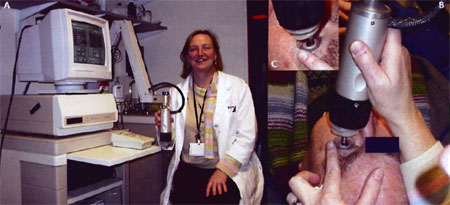 Figure 1. The commercially available Humphrey UBM (Model 840; Carl Zeiss
Meditec Inc., Dublin, CA) with the uf grade from Paradigm Medical Industries,
Inc. (Salt Lake City, UT) has a hand-held probe mounted on an arm (A). Here,
clinician Libba Affel performs the scan while the patient is in a supine
position; she uses an eyecup containing methylcellulose or saline solution
(B). She places the ultrasound tip into the fluid to obtain an image (C).
Figure 1. The commercially available Humphrey UBM (Model 840; Carl Zeiss
Meditec Inc., Dublin, CA) with the uf grade from Paradigm Medical Industries,
Inc. (Salt Lake City, UT) has a hand-held probe mounted on an arm (A). Here,
clinician Libba Affel performs the scan while the patient is in a supine
position; she uses an eyecup containing methylcellulose or saline solution
(B). She places the ultrasound tip into the fluid to obtain an image (C).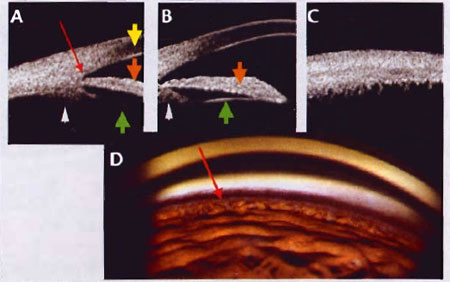 Figure
2. The UBM images show a healthy eye with a wide anterior chamber angle
(A through Q.The ciliary body (white arrow), lens capsule <green arrow),
cornea (yellow arrow), iris (orange arrow), and scleral spur (red arrow)
are visible. A cross-section displays normal ciliary processes of normal
thickness (C). A goni-oscopic photograph of the same eye shows the scleral
spur (red arrow) (D). Figure
2. The UBM images show a healthy eye with a wide anterior chamber angle
(A through Q.The ciliary body (white arrow), lens capsule <green arrow),
cornea (yellow arrow), iris (orange arrow), and scleral spur (red arrow)
are visible. A cross-section displays normal ciliary processes of normal
thickness (C). A goni-oscopic photograph of the same eye shows the scleral
spur (red arrow) (D).NORMAL ANATOMY Aqueous is produced in the ciliary body processes. It then flows through the posterior chamber, behind the lens and iris, through the pupil, and into the anterior chamber. Aqueous drains through the trabecular meshwork and ciliary body face, which are collectively referred to as the anterior chamber angle (Figure 2). In an eye with a clear cornea and an open angle that has some pigmentation of the trabecular meshwork, the angle's structures can be easily examined using gonioscopy. UBM can help the clinician visualize structures behind the iris. It is also of benefit when the anterior chamber structures cannot be clearly seen, such as through a cloudy cornea, with an obstructed view from the iris, or due to a lack of pigmentation in the trabecular meshwork. PRIMARY ACUTE ANCLE-CLOSURE GLAUCOMA Overview Primary acute angle-closure glaucoma occurs when the iris mechanically blocks the trabecular meshwork and ciliary body face, thus causing a rapid elevation of IOP. Specifically, primary acute angle-closure glaucoma occurs from pupillary block or plateau iris syndrome. Pupillary Block Primary acute angle-closure glaucoma caused by pupillary block occurs in anatomically predisposed individuals such as persons with narrow angles and a shallow anterior chamber (Figure 3). The prevalence of narrow angles varies by ethnicity and occurs more commonly in Asians than in whites or blacks. The prevalence of narrow angles in whites in the Framing-ham Study was 3.8%.2 In the ethnically mixed black and white population of the Baltimore Eye Study, the prevalence of narrow angles was approximately 2.1%3 versus 8.5% in a Vietnamese population.2 Additional risk factors for pupillary block include hyperopia and older age. The cause of narrow angles is unknown but is related to the anterior-posterior growth of the lens that occurs with age. The crystalline lens grows in all people, but it results in a narrow angle and shallow anterior chamber only in some individuals. When the pupil dilates, the vector forces of the iris' dilatory muscle pull the iris not only centripetally, but posteriorly as well. The subsequently increased apposition between the iris and the lens blocks the flow of aqueous through the pupil. Continuing secretion of aqueous humor creates a pressure differential between the anterior and posterior chambers that bows the iris forward (ie, iris bombe) and obstructs the angle. 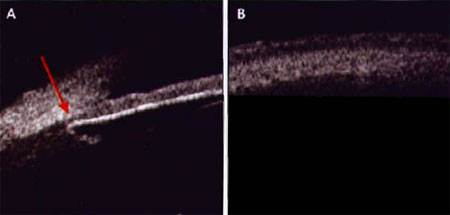 Figure 3. This eye (shown here by UBM) was relieved of an acute angle-closure
attack using intravenous mannitol and topical aqueous suppressants.The shallow
angle of the anterior chamber without iris bombe indicates that the angle
closure has temporarily broken.The red arrow approximates the location of
the scleral spur (A). The normal ciliary body thickness is shown in cross-section
(B). This patient was successfully treated with laser iridotomy.
Figure 3. This eye (shown here by UBM) was relieved of an acute angle-closure
attack using intravenous mannitol and topical aqueous suppressants.The shallow
angle of the anterior chamber without iris bombe indicates that the angle
closure has temporarily broken.The red arrow approximates the location of
the scleral spur (A). The normal ciliary body thickness is shown in cross-section
(B). This patient was successfully treated with laser iridotomy.UBM images typically show apposition of the peripheral iris against the trabecular meshwork. The ciliary body is angled downward. Moving peripherally from the pupil, the iris has a bowed appearance, but no angulation. Plateau Iris Plateau iris configuration is a rare condition in which the ciliary processes are anterior and rotated forward. As a result, the far peripheral iris is thrust anteriorly toward the drainage angle. This configuration causes a sharp angulation, with the remainder of the iris planar and the anterior chamber deep (hence the term plateau iris) (Figure 4). During dynamic gonioscopy (ie, gentle indentation on the cornea to watch the movement of the peripheral iris roll), the anteriorly rotated ciliary body makes the peripheral iris resistant to posterior bowing. UBM can show the location of the ciliary body and the distinctive angulation of the iris. Mechanical blockage of the drainage angle due to bunching of the peripheral iris during dilation can cause primary acute angle-closure glaucoma. Iris bombe does not occur. As in cases of pupillary block, physicians perform medical treatment to relieve the attack and clear the cornea. Long-term medical therapy with cholinergic drugs is very effective when patients are willing to take the medication regularly and for an indefinite period. When needed, the initial surgical procedure is a laser iridotomy to relieve any component of relative pupillary block. If the angle does not significantly deepen, then argon laser irido-plasty is indicated. During iridoplasty, the surgeon uses an argon laser to create thermal burns in the peripheral iris to cause contraction of the local iris tissue toward the burn. As the iris pulls away from the angle, the depth of the angle increases. SECONDARY CAUSES OF ANCLE CLOSURE WITH A SHALLOW CHAMBER Aqueous Misdirection Syndrome Aqueous misdirection syndrome, also known as malignant glaucoma, is also associated with elevated IOP and a shallow anterior chamber. Typically, this con-. dition develops following an ophthalmic procedure. The syndrome alters aqueous flow such that the aqueous is directed posteriorly and accumulates in the vitreous. As a result, the ciliary processes, the lens/IOL, and anterior vitreous face move forward, causing the angle to close. UBM can aid clinicians in identifying aqueous misdirection syndrome by allowing them to observe the flattened ciliary processes, which are pathognomic of the disorder (Figure 5). Occasionally, aqueous misdirec¬tion syndrome responds to medical treatment with systemic hyperosmotic agents and aqueous sup¬pressants, which can relieve the immediate rise in IOP, and with cycloplegics to pull the iridolenticular diaphragm posteriorly. If medical management fails, then the physician must break the anterior hyaloid face with either an NdYAG laser or a mechanical disruption (ie, vitrectomy) to allow fluid to flow freely between the vitreous cavity and anterior chamber. Typical UBM findings include apposition between the iris and the cornea. The hallmark finding is a flattening of the ciliary body processes. Swelling of the Ciliary Body Concentric swelling of the ciliary body can cause its and the iridolenticular diaphragm's forward rotation. Angle-closure glaucoma with a shallow anterior chamber may result. 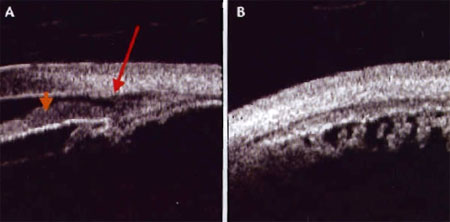 Figure
4. UBM reveals a plateau iris configuration (A and B). Moving peripherally
from the pupil, the iris (orange arrow) is planar then angles sharply downward
creating a narrow approach and a slit-like space between the trabecular
meshwork peripheral iris.The red arrow shows the approximate location of
the scleral spur. Figure
4. UBM reveals a plateau iris configuration (A and B). Moving peripherally
from the pupil, the iris (orange arrow) is planar then angles sharply downward
creating a narrow approach and a slit-like space between the trabecular
meshwork peripheral iris.The red arrow shows the approximate location of
the scleral spur.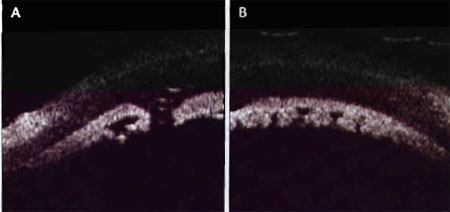 Figure
5. UBM shows aqueous misdirection syndrome following a tube shunt procedure
(A). The UBM image of another eye with aqueous misdirection syn¬drome shows
flattened ciliary body processes in cross-section (B). Figure
5. UBM shows aqueous misdirection syndrome following a tube shunt procedure
(A). The UBM image of another eye with aqueous misdirection syn¬drome shows
flattened ciliary body processes in cross-section (B).The ciliary body may swell due to inflammation as an idiosyncratic reaction to a medication (eg, compounds containing sulfamate moieties). Topiramate, an antiseizure medication containing sulfonamide, is gaining wide popularity for preventing migraine headaches. The agent has been associated with swelling of the ciliary body that rotates the iri-dolenticular diaphragm forward and results in a spectrum of symptoms, ranging from acute myopia to angle-closure glaucoma. UBM is useful in the diagnosis of angle closure induced by sulfonamide, because it shows the swollen ciliary body processes (Figure 6). 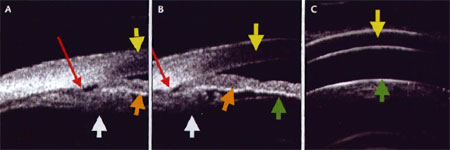
Figure 6. As visible on UBM, topiramate has induced angle-closure glaucoma.The ciliary body process is markedly swollen (white arrow), and there is no iris bombe.The scleral spur (red arrow), cornea (yellow arrow), iris (orange arrow), and lens cap¬sule (green arrow) are also visible (A through C). The treatment is supportive because the swelling will resolve following discontinuation of the medication. Clinicians may prescribe topical aqueous suppressants to lower IOP while the episode abates but should avoid medications that contain sulfonamide. Peripheral iridotomy is not indicated, because the mechanism is not related to pupillary block. CONCLUSION UBM is noninvasive and can provide useful anatomic information on structures hidden by the iris or a cloudy cornea. This information can assist with the differentiation of the various etiologies of narrow or closed angles. G |
|
 |
|



